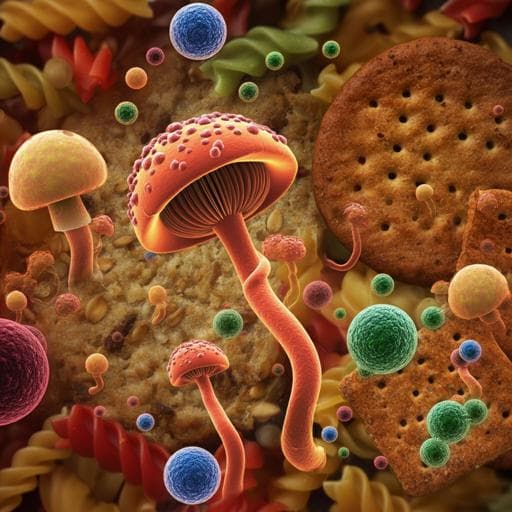
Food Science and Technology
Quantification of 700 mycotoxins and other secondary metabolites of fungi and plants in grain products
M. Sulyok, M. Suman, et al.
This study by Michael Sulyok, Michele Suman, and Rudolf Krska showcases a novel liquid chromatography-tandem mass spectrometry method that accurately quantifies over 700 mycotoxins in various food products. The results reveal critical findings about the prevalence of enniatin and deoxynivalenol in European samples, shedding light on food safety.
~3 min • Beginner • English
Introduction
The study addresses the need for robust, wide-scope LC-MS/MS methods to quantify mycotoxins and other plant-derived toxins in complex processed grain products (pasta, biscuits, crackers, musli) where matrix composition varies widely among brands and products. LC-MS/MS is the standard for low molecular weight contaminants due to its selectivity, robustness, and multi-analyte capability, enabling minimal sample cleanup. Regulatory limits in the EU (e.g., Commission Regulation 2023/915) necessitate reliable methods for compliance testing, yet few validations exist for processed cereal products. Processed foods can exhibit significant variability and relative matrix effects, which can increase measurement uncertainty. Official guidelines differ in how they address relative matrix effects: EU 2021/808 provides explicit criteria for recovery and matrix factors across multiple lots, while EU 2023/2782 suggests supplementing precision data with proficiency testing, partly because stable isotope internal standards exist for many regulated mycotoxins. Building on previous work in raw commodities, the goal here was to evaluate method performance in processed matrices using seven different brands per matrix to capture relative matrix effects and extraction efficiency variability, and to apply the method to market samples for occurrence data.
Literature Review
Prior work established LC-MS/MS as a key tool for multimycotoxin analysis in cereals and related foods, including methods with minimal cleanup and QuEChERS-like approaches. Several studies have focused on mycotoxin determination in cereal-based foods (biscuits, pasta, breakfast cereals, crackers) but comprehensive validations for processed products remain limited (e.g., Frenich 2009; Blesa 2012; Beltran 2013; Capriotti 2014; De Santis 2017; Škrbić 2017; Tolosa 2017; Zhang 2017; Bouafifssa 2018; Medina 2019; Narváez 2023). Earlier work by the authors validated a dilute-and-shoot LC-MS/MS method for >500 analytes in food crops and explored uncertainty contributions from lot-to-lot variation. Regulatory and guidance documents (EU 2021/808; EU 2023/2782; EU 2023/915; SANTE guidance) inform validation criteria (recovery, matrix effects, precision, identification). Additional literature addresses chromatographic strategies for plant alkaloids (e.g., two-dimensional LC for pyrrolizidine alkaloids). This study extends the analyte scope and assesses performance in processed matrices while considering relative matrix effects and proficiency testing outcomes.
Methodology
Study design and scope: The previously published LC-MS/MS protocol was extended to nearly 900 metabolites (about 170 without quantitative standards), covering mycotoxins, other fungal metabolites, and plant toxins (including pyrrolizidine and tropane alkaloids). sMRM parameters were optimized to accommodate 1090 transitions (positive ESI) and 736 (negative ESI), with a target cycle time increased from 1.0 s to 1.4 s (minimum dwell times 20 ms positive, 25 ms negative) while maintaining at least 10 data points per ~15 s peak.
Samples: For each matrix (pasta, biscuits, crackers, musli) seven individual low-contamination samples/brands were selected for spiking, representing variability in grains, ingredients, and additives. Additionally, 157 commercial samples from the European market were analyzed. Proficiency test samples came from BIPEA.
Chemicals and standards: LC-MS grade solvents and reagents were used. Single-analyte stock solutions (typically 250 µg/mL in acetonitrile; some in ACN/water 1:1, methanol, or water) were combined into 78 intermediate mixes (10 analytes each) and a fresh multi-analyte standard prior to spiking. Solutions stored at −20 °C.
Sample preparation (dilute-and-shoot): Samples were milled/homogenized. For routine extracts, 5 g sample was extracted with 20 mL ACN/water/acetic acid 79:20:1 (v/v/v), shaken 90 min; 500 µL supernatant was diluted 1:1 with ACN/water/acetic acid 20:79:1. Inject 5 µL into LC-MS/MS. For spiking, a miniaturized protocol used 0.25 g and 1 mL extraction solvent to economize standards.
LC-MS/MS instrumentation: An Agilent 1290 UHPLC coupled to a Sciex QTrap 5500 with TurboV ESI source. Column: Phenomenex Gemini C18, 150 × 4.6 mm, 5 µm, with C18 guard (4 × 3 mm). Column at 25 °C. Flow 1.0 mL/min. Mobile phases (both with 5 mM ammonium acetate): A = MeOH/water/acetic acid 10:89:1; B = 97:2:1. Gradient: 0–2 min 100% A; 2–5 min linear to 50% B; 5–14 min linear to 100% B; hold 14–18 min at 100% B; re-equilibrate 2.5 min at 100% A. Injection volume 5 µL. Data acquired in sMRM in positive and negative modes in separate runs, detection windows 40 s (positive) and 46 s (negative), cycle time 1400 ms, MS pause 3 ms. Two transitions per analyte (except 3-nitropropionic acid and moniliformin). Identification required ion ratio within ±30% of standard (SANTE/12089/2016) and retention time within ±0.03 min (in-house).
Calibration and quantification: External calibration with neat solvent standards. Working solution prepared by mixing multi-analyte standard with certified fumonisin standards B1, B2, B3 (added late due to stability), then serial dilutions (1:3 to 1:3000 etc.). Linear 1/x weighted calibration curves were constructed (MultiQuant 3.0.3). Spiked samples and post-extraction spikes were analyzed against solvent standards to derive apparent recovery (RA), signal suppression/enhancement (SSE), and extraction recovery (RE).
Validation experiments: Repeatability (RSDr) was assessed using seven different individual spiked samples per matrix analyzed within one 2.5-day sequence. Intermediate precision (within-lab reproducibility, RSDWLR) used seven technical replicates of one sample per matrix, one analyzed per week over seven weeks. Expanded relative measurement uncertainty Ur,exp was calculated as Ur,exp = 2*sqrt(RSDr^2 + RSDWLR^2). LOD/LOQ were determined from low-level spikes following the Eurachem guide. Proficiency testing performance (z-scores) was monitored continuously across matrices and analytes.
Real-world occurrence: The extended method was applied to 157 commercial samples to assess occurrence of regulated mycotoxins and other metabolites.
Key Findings
- Scope and acquisition: Method extended to almost 900 metabolites; sMRM schedule optimized (1090 positive and 736 negative transitions) with 1.4 s cycle time and ≥10 points/peak.
- Recoveries and matrix effects (730 quantified metabolites across four matrices):
- Apparent recovery (RA) within 70–120% for 85–88% of analytes.
- Extraction recovery (RE) within 70–120% for 92–94% of analytes.
- Only 7–14% of analytes showed significant matrix effects (SSE deviation > ±20%).
- 26 analytes outside 70–120% RE; roughly half had very low/irreproducible extraction (incompatible), the other half had RE 50–70% with RSD <20% (still acceptable for some applications).
- For some analytes (e.g., enniatins, abscisic acid, brevianamide F, cordycepin, cyclo(L-Pro-L-Tyr), infectopyron, tryptophol), lack of true blanks caused apparent enhancement; for others (e.g., cyclopiazonic acid, altenusin, altersetin, (epi-)equisetin, demethylsulochrin, methylequisetin, rugulosin, sorbicillactone A, violaceol I/II), matrices appeared to protect against degradation/adsorption, yielding enhanced signals (up to 4× for rugulosin/sorbicillactone A, 30–50× for violaceols) not attributable to classic ionization enhancement.
- Precision and uncertainty:
- Repeatability: >70% analyte/matrix combinations had RSDr <10%; 95–98% met RSDr <20%.
- Intermediate precision: RSDWLR <20% for 98.9–99.2% of analytes depending on matrix (superior to RSDr as relative matrix effects are absent in this design).
- Expanded measurement uncertainty Ur,exp met the <50% criterion for 95–98% of analytes.
- Sensitivity:
- LOQs (biscuits and musli) agreed within a factor of 2 for all but 42 compounds (differences often due to traces or interferences). LOQs were below EU regulatory limits for mycotoxins in cereal-based products; for baby food limits (aflatoxins, ergot and tropane alkaloids) LOQs were in the range or slightly above these more stringent values.
- Trueness (proficiency testing):
- 1118 results for 30 analytes since Oct 2019: 68.2% with z between −1 and 1; 96.2% with z between −2 and 2. In a rusk matrix, all z-scores were between −1 and 1 except 3-ADON (z = 1.15), confirming satisfactory trueness relative to peer methods.
- Real-world occurrence in 157 European market samples:
- Regulated mycotoxins: Deoxynivalenol (DON) detected in ~two-thirds of samples (below EU limits); zearalenone in ~1/6; other trichothecenes and ochratoxin A rarely (one OTA-positive sample); fumonisins and aflatoxins not detected. The sum of ergot alkaloids exceeded the July 2024 limit (50–150 µg/kg range depending on product) in a few samples. Crackers had the highest positivity rate (68%), aligning with prior rye-based findings.
- Other metabolites: Enniatins detected in the majority of samples at sub- to low µg/kg median levels. Culmorin and 15-hydroxyculmorin common at levels similar to DON. Alternariol exceeded the 2 µg/kg indicative level for grain-based baby food in two samples; AOH-monomethyl ether and tenuazonic acid were below indicative values. Infectopyron exceeded 100 µg/kg in some cases (consistent with milling oats reports). Questiomycin A was present in 61 samples (max 534 µg/kg).
- Plant toxins: No tropane or pyrrolizidine alkaloids per EC 2023/915 were detected (except low erucifolin). Cyanogenic glucosides (linamarin, lotaustralin, prunasin), glycoalkaloids (solanine, chaconin), xanthotoxin, and biochanin occurred in up to half the samples, sometimes reaching low mg/kg. Several unspecific metabolites (e.g., cyclic dipeptides, anthraquinones) were widespread up to ~40 mg/kg.
- Compliance: All market samples complied with current EU mycotoxin limits except a few with elevated ergot alkaloid sums.
Discussion
The results demonstrate that a dilute-and-shoot LC-MS/MS method can reliably quantify hundreds of mycotoxins and plant metabolites in complex processed grain matrices, meeting regulatory performance criteria across diverse brands and formulations. Contrary to expectation, processed matrices showed reduced absolute and relative matrix effects compared to raw commodities, likely due to processing-induced decreases or transformations of interfering low molecular weight matrix components. Repeatability across different brands was strong, and intermediate precision was even better when relative matrix effects were eliminated, highlighting that relative matrix effects are a key contributor to overall uncertainty. LOQs achieved comfortably meet regulatory needs for general cereal products, supporting the method’s suitability for compliance testing. Application to market samples confirms that while overt exceedances are rare (except some ergot alkaloid sums), low-level co-occurrence of multiple natural toxins is common, especially enniatins and Fusarium metabolites like DON and culmorins, underlining the relevance of broad-spectrum surveillance and risk assessment for chronic low-dose mixtures.
Conclusion
This study extends and validates a high-throughput LC-MS/MS dilute-and-shoot method for the simultaneous quantification of nearly 900 fungal and plant metabolites in processed grain products. Performance metrics were robust across diverse brands within each matrix, with most analytes meeting target ranges for recovery, precision, and expanded measurement uncertainty; LOQs generally lay below applicable regulatory limits. Real-world monitoring showed widespread low-level contamination by multiple metabolites, though regulatory non-compliance was rare, apart from occasional ergot alkaloid sum exceedances. The findings support the method’s use for routine compliance and surveillance in processed cereals.
Future research should address: (i) improved chromatographic strategies (e.g., alkaline or 2D separations) for isomeric plant toxins and epimers that co-elute under acidic conditions; (ii) expanded use of stable isotope internal standards to further mitigate matrix effects; (iii) better characterization of extraction efficiency for incurred contaminants versus spiked samples; and (iv) toxicological investigations into chronic exposure to low-level mixtures of natural toxins.
Limitations
- Lack of true blank matrices for some analytes (e.g., enniatins, abscisic acid, infectopyron) led to apparent signal enhancement in spiking experiments.
- Certain isomeric plant toxins and epimer pairs (e.g., indicine/intermedine/lycopsamine and N-oxides; ergot epimers) are not baseline-separated under acidic LC conditions; alkaline or 2D LC would be preferable for dedicated quantification.
- About half of the analytes outside the RE 70–120% range showed very low/irreproducible extraction, indicating incompatibility with the extraction protocol.
- Spiking-based assessment of extraction efficiency may bias results relative to incurred contamination, although proficiency testing did not suggest systematic underestimation.
- For some analyte–matrix combinations, LOQs approach or slightly exceed the stricter limits applicable to baby foods (e.g., aflatoxins, ergot and tropane alkaloids).
- External calibration with neat solvent standards was used; stable isotope internal standards were not universally applied across the broad analyte list.
Related Publications
Explore these studies to deepen your understanding of the subject.







